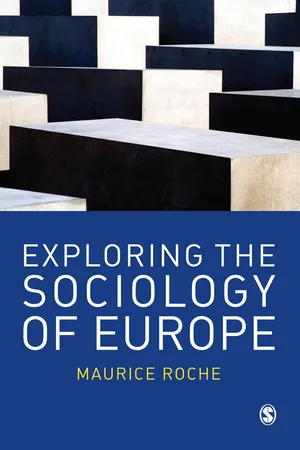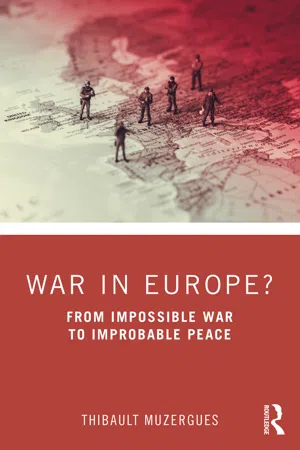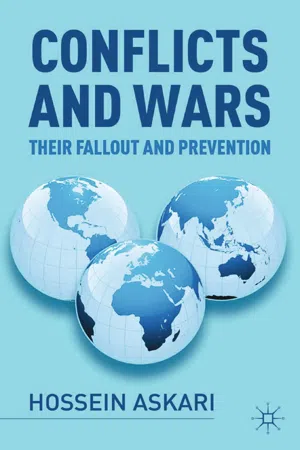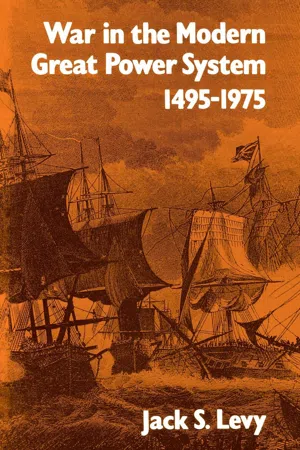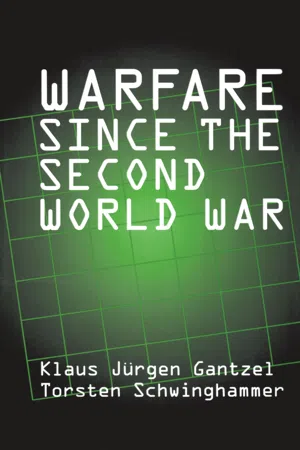History
European Wars
The European Wars refer to a series of conflicts that took place within Europe, involving various European powers and nations. These wars were often driven by territorial disputes, power struggles, and ideological differences, and they had significant impacts on the political, social, and economic landscape of Europe. The European Wars encompass a wide range of conflicts, including the Napoleonic Wars, the Thirty Years' War, and the World Wars.
Written by Perlego with AI-assistance
Related key terms
1 of 5
6 Key excerpts on "European Wars"
- eBook - ePub
Exploring the Sociology of Europe
An Analysis of the European Social Complex
- Maurice Roche(Author)
- 2009(Publication Date)
- SAGE Publications Ltd(Publisher)
societal dimensions of economy, polity and culture. The chapter is divided into two main sections. The first section begins by descriptively outlining the scale of the phenomenon of war in Europe over the course of the modern period. It then steps back to take an analytic perspective on European society in terms of the ways in which war can be interpreted as embodying changes in Europe’s deep social structures. The second section outlines the social relevance of war for the modernisation of European society understood as simultaneous and interconnected changes in the three main social dimensions. It proceeds in three stages looking in turn at the economic, cultural and political dimensions. It looks at the development of Europe as a complex of warfare states, and thus at the relevance of war in terms of European states as respectively contexts of capitalism, Christianity and political difference.One way to organise such a summary discussion is by using the abstract and arguably over-simplified analytical notions of social cause and effect. In this kind of discourse we might visualise the phenomenon of war, on the one hand, as an effect of underlying societal causes and conditions, and, on the other hand, as itself a cause of social effects. Less paradoxically and more realistically, we can conceptualise social causal and effect factors operating through feedback loops, cycles and iterations over time. We can thus visualise war as a dynamic mediating and catalytic element in these feedback processes, here providing both a practical and symbolic vent and expression for broader social forces, there creating major social impacts and challenges which, in turn, come to enable and motivate further cycles of war-making. In all societal contexts in every European nation-state and society – whether here acting more as a cause, or there acting more as an effect – the commitment to war-making manifested itself both in high-status, state-based and specialised social institutions and traditions, and also in widely generalised public experiences and collective memories.The emergence of a European complex in the form of a Europe of different nation-states has no doubt been mediated and driven by particular wars. But it has also been mediated and driven by the commonalities involved in the priority which all European countries, as warfare states, have chosen to give (and often have had no choice but to give) to war-making and its requirements and consequences. This emergence has been marked by the common paradoxes and dialectics of war , namely that positive and constructive things can sometimes develop alongside and even on the basis of this sphere of destruction and negativity. Achieving the status of warfare states 6 has typically carried political and structural implications. Common and consequential implications in many European societies include those of also (and we might add, thereby) achieving the interconnected statuses of being both citizen states and welfare states . We have noted some of the distinctive European patterns of and preoccupations with the development of citizenship earlier. Later we need to explore the connected theme of Europeans’ varying commitments to welfare and ‘the European social model’ (Chapter 6 and Part 3 ). Each of these developments in modernity can be analysed socio-historically and be shown to be connected with the influential role of warfare in the experience and shaping of European societies. This chapter thus helps to prepare the way for the discussion of these issues in Part 3 - eBook - ePub
War in Europe?
From Impossible War to Improbable Peace
- Thibault Muzergues(Author)
- 2022(Publication Date)
- Routledge(Publisher)
Whether looked at from a geographical or cultural perspective, Europe seems almost conditioned to be defined by its relationship with Mars. But if war is part of the continent’s DNA, this does not necessarily mean that Europe has to find itself in a permanent state of war, as the history of the past 75 years has shown. We will get back to this period in a moment, but it is worth examining the long history of the continent to understand the complexity of the relationship between Mars and Europe. Viewed over a long period of time, that relationship does look straightforward, and it is passionate. While it is true that there have been periods of peace in Europe for varying lengths of time, an overview of the continent’s long history shows that the peaceful times Europeans have been living constitute a remarkable exception in an otherwise very bellicose record.That European history may be principally punctuated by battles and armed conflicts should come as no surprise, for war has in fact defined the rise and fall of nations as much as the wellbeing and ruin of European communities and individuals. War has actually followed a pendulum movement between two opposite dynamics: one went toward unification (expansion of Rome, constitution of the Carolingian or Napoleonic Empire, etc.), the second toward atomization, which again presupposed more or less long and bloody conflicts.30 This double movement was almost perpetual in European history, in the sense that there were very few periods when the international or imperial system stabilized sufficiently to make war unnecessary. Moreover, an examination of these periods of Pax Europaea shows that when they did occur, they were geographically limited and fragile enough to guarantee the existence of armed conflict in one part of the continent even when the other was prosperous and peaceful – the 1990s come to mind here, as Europe found itself at peace and (at least in the West) prosperous while the Balkans disintegrated.If we are to take a look at the history of the relationship between war and Europe, our paths must first lead us to Greece before Rome. Greece is the true cradle of European civilization. The continent’s first cities developed there (although they were then more oriented toward the Mediterranean than toward the hinterland, unlike Egypt, for example31 ), and it is also in Greece, more precisely during the battles of Thermopylae and Salamis, that the first break between a Greek civilization based in Europe and the Near and Middle Eastern civilizations occurred. For the needs of the fight against Xerxes’s Persia, the Greeks had coalesced into an alliance to defend their homeland – but as soon as the threat disappeared, they took up their weapons again to fight among themselves and thus make sure that no power could take over the others. Athens’s attempt to build hegemony was checked by the declining power of Sparta. They locked themselves into 30 years of destructive warfare.32 - eBook - PDF
Conflicts and Wars
Their Fallout and Prevention
- Hossein Askari(Author)
- 2012(Publication Date)
- Palgrave Macmillan(Publisher)
Chapter 2 A Glance at Recent Conflicts and Wars A Brief Accounting of Recent Conflicts and Wars The early part of the nineteenth century, from 1815 to 1845, was a peaceful period in Europe with unprecedented industrial expansion. In America, there was political tranquility with rapid economic growth up to the out- break of the American Civil War. 1 World military expenditures were gen- erally low because many imagined that peace would be permanent. By mid-century, however, tensions were increasing and intense rivalry once again developed between England and France. The latter half of the cen- tury was marked by a number of conflicts: the Crimean War, the American Civil War, the Austro-Prussian War, the Franco-Prussian War, the Russo- Turkish War, the Boer War, and the Spanish-American War (Zapotoczny). According to the COW (Correlates of War, at the University of Michigan) project, 2 there have been around 490 major conflicts from the beginning of the nineteenth century, with more than 38 million battle-related fatalities; and since 1945 alone, there have been roughly 170 conflicts with nearly 6 million battle-related deaths; while according to SIPRI, since 1988 world- wide military expenditures have accounted for more than $26 trillion (in 2009 constant prices). 3 Heightened global concern about renewed interstate conflicts after World War I brought about the establishment of the League of Nations, which was later (after World War II) replaced by the United Nations Conflicts and Wars 24 because countries were encouraged to use diplomacy to solve emerging conflicts. Many issues such as self-determination, national sovereignty, and the territorial integrity of countries were not addressed after World War II, resulting in conflicts in the ensuing period of decolonization. - eBook - PDF
Pandora’s Box
A History of the First World War
- Jörn Leonhard, Patrick Camiller(Authors)
- 2018(Publication Date)
- Belknap Press(Publisher)
And the lingering effects of the war included the army of wounded and the need for long-term public provision for war invalids. It was they who gave a face to the war in peace. The war had revealed what was possible in the name of the nation and nation-state, and what was possible had become evident in the widespread breaking of taboos and loss of inhibitions. A specific kind of “European social-ization,” which had developed since the late seventeenth century against a background of religious civil wars, was entering into crisis.2 That order had been based on the idea of a set of rules to regulate wars, to prevent conflicts from escalating between sovereign states, to channel violence and make it calculable. After the experiences of the French Revolution and the Napole-onic Wars, this order had again been operative in the period between 1815 and 1914—and for a long time the international order had proved flexible in Burdens | 893 adjusting to new nation-states and imperial outreach. But that epoch came to an end with the First World War. Between August 1914 and November 1918, European countries lost the ability to achieve external and internal peace on their own or to trust that it would continue in the long term. This marked a watershed in the global perception of Europe and the credibility of the international model represented by its states. The victor of the world war was not a nation, a state, or an empire, and its outcome was not a world without war. The true victor was war itself— the principle of war and the possibility of total violence. In the long run, this weighed all the more heavily because it contradicted a leitmotif that had developed during the war and had for many been a decisive reason to continue it with all possible means. - eBook - ePub
War in the Modern Great Power System
1495–1975
- Jack S. Levy(Author)
- 2021(Publication Date)
- The University Press of Kentucky(Publisher)
19Imperial and colonial wars present an even more complex set of conceptual and operational problems. Part of the difficulty in identifying imperial wars is the ambiguity of the concept, which has been ideologically contaminated and has assumed a diversity of meanings. The concept of colonial war is more easily defined and more manageable, but it is too restrictive for my theoretical purposes. Colonies can be defined legally and identified by the presence of formal charters. Colonial wars could then be defined as all wars involving a colony and meeting certain other criteria (for example, battle deaths). But this process would exclude the phenomenon of “informal imperialism,”20 in which conflicts arise because of economic, political, or military expansion into areas where a formal administrative system is not established and a colonial charter not formally granted (for example Russian expansion in Asia).Singer and Small appear to avoid this problem by operationally defining imperial and colonial wars (which they fail to distinguish theoretically) as extrasystemic wars (those involving a system member against a nonmember). But this concept incorporates a variety of wars, including those arraying system members against small European states (for example, Polish wars of 1831 and 1863-64 and the Hungarian war of 1848-49) as well as those in which European Powers fought against weaker non-European political entities (Franco-Indochinese wars of 1882-84 and 1945-54). But these wars are sufficiently different that they should not be classified together as imperial wars. It is preferable to adopt the more traditional conception and consider imperial wars to be those in which a major European state (not necessarily a Great Power) fought a relatively weak non-European entity. In applying these criteria to the post-1815 period, therefore, the Singer-Small extrasystemic wars involving weaker European states are not classified as imperial wars. (Instead, most can be classified as civil wars, for they involved semisovereign dependencies of the Powers. In any case, they are excluded from this compilation.) Wars involving non-European entities who qualify as members of the international system are classified as interstate wars. - eBook - ePub
- Torsten Schwinghammer(Author)
- 2018(Publication Date)
- Routledge(Publisher)
For this reason our criteria for aggressor consists of who initiates the use of weaponry, rather than which side fires the first shot. Obviously there are instances where this cannot be determined. In cases where military action does not provide a clear indication of who attacked whom we assess from which side the decisive political direction toward war emanated. 9 2.3 Regional Categorization of Countries at War By regions we mean “world regions,” political-geographic areas which encompass a number of lands. We will make clear from the context if a “region” is used to indicate a local area within a land (e.g., southern Sudan) or an ethnographically or culturally demarcated area which can extend over the territory of several formal states (e.g., Kurdistan). In light of material and temporal differences in the process of global development it is important to determine regional differences concerning susceptibility to war. It is often difficult to demarcate the regions and allocate a particular land to this or the other region. Cartographers, physical and social geographers, historians, political scientists, and ethnologists, among others, address these issues from fundamentally different perspectives. We have approached our classifications practically, focusing primarily on areas of political conflict, interconnections, and comparisons. We differentiate the following regions as follows (Africa is substantially subdivided more than the other continents because of its relatively large number of states): 10 Europe (abbr. EUR), encompasses North, West, South, Southeast, Middle and Eastern Europe, the entire former Soviet Union and the present Russian Federation, the Baltic states, Belarus, Ukraine and Moldova
Index pages curate the most relevant extracts from our library of academic textbooks. They’ve been created using an in-house natural language model (NLM), each adding context and meaning to key research topics.
